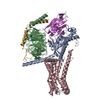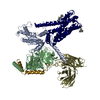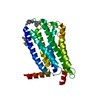+Search query
-Structure paper
| Title | Structure of GPR101-Gs enables identification of ligands with rejuvenating potential. |
|---|---|
| Journal, issue, pages | Nat Chem Biol, Vol. 20, Issue 4, Page 484-492, Year 2024 |
| Publish date | Nov 9, 2023 |
 Authors Authors | Zhao Yang / Jun-Yan Wang / Fan Yang / Kong-Kai Zhu / Guo-Peng Wang / Ying Guan / Shang-Lei Ning / Yan Lu / Yu Li / Chao Zhang / Yuan Zheng / Shu-Hua Zhou / Xin-Wen Wang / Ming-Wei Wang / Peng Xiao / Fan Yi / Cheng Zhang / Peng-Ju Zhang / Fei Xu / Bao-Hua Liu / Hua Zhang / Xiao Yu / Ning Gao / Jin-Peng Sun /  |
| PubMed Abstract | GPR101 is an orphan G protein-coupled receptor actively participating in energy homeostasis. Here we report the cryo-electron microscopy structure of GPR101 constitutively coupled to Gs heterotrimer, ...GPR101 is an orphan G protein-coupled receptor actively participating in energy homeostasis. Here we report the cryo-electron microscopy structure of GPR101 constitutively coupled to Gs heterotrimer, which reveals unique features of GPR101, including the interaction of extracellular loop 2 within the 7TM bundle, a hydrophobic chain packing-mediated activation mechanism and the structural basis of disease-related mutants. Importantly, a side pocket is identified in GPR101 that facilitates in silico screening to identify four small-molecule agonists, including AA-14. The structure of AA-14-GPR101-Gs provides direct evidence of the AA-14 binding at the side pocket. Functionally, AA-14 partially restores the functions of GH/IGF-1 axis and exhibits several rejuvenating effects in wild-type mice, which are abrogated in Gpr101-deficient mice. In summary, we provide a structural basis for the constitutive activity of GPR101. The structure-facilitated identification of GPR101 agonists and functional analysis suggest that targeting this orphan receptor has rejuvenating potential. |
 External links External links |  Nat Chem Biol / Nat Chem Biol /  PubMed:37945893 PubMed:37945893 |
| Methods | EM (single particle) |
| Resolution | 2.89 - 3.3 Å |
| Structure data | EMDB-37356, PDB-8w8q: EMDB-37357, PDB-8w8r: EMDB-37358, PDB-8w8s: |
| Chemicals |  ChemComp-U7D: |
| Source |
|
 Keywords Keywords | MEMBRANE PROTEIN / GPCR / orphan receptor / GPR101 / constitutive activity / cryo-EM / structural protein |
 Movie
Movie Controller
Controller Structure viewers
Structure viewers About Yorodumi Papers
About Yorodumi Papers









 homo sapiens (human)
homo sapiens (human)
